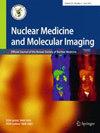The Biodistribution and Utility of 99mTc-Ethylenedicysteine-Deoxyglucose (99mTc-Glucosamine) in the Identification of Active Disease in Patients with Rheumatoid Arthritis—a Single Center Prospective Study
IF 2.7
Q3 RADIOLOGY, NUCLEAR MEDICINE & MEDICAL IMAGING
引用次数: 0
Abstract
Abstract Purpose Our objectives were to investigate the utility of 99m Tc-ethylenedicysteine-deoxyglucose (ECDG) in identifying active disease in the joints of patients with rheumatoid arthritis (RA), as well as to evaluate the biodistribution of this radiopharmaceutical. Methods A prospective study was conducted at the Department of Nuclear Medicine of the University of the Free State/Universitas Academic Hospital in Bloemfontein, South Africa. Twenty-two participants from the rheumatology department diagnosed with RA according to the ACR/EULAR classification criteria were enrolled. Participants were injected with 20–25 mCi of 99m Tc-ECDG. Flow, blood pool, whole body, delayed static, and SPECT/CT images were acquired. Known sites of disease were qualitatively assessed for intensity of uptake, and disease severity was graded (Grade 0–3). Results Twenty-two participants were studied. The median (interquartile range) age was 59 (49–68) years, and the majority ( n = 21; 95.5%) were females. There was abnormal increased uptake of 99m Tc-ECDG noted in majority of the sites of known disease, including unknown sites. SPECT/CT imaging localized radiotracer uptake specifically to the synovial space. Similar biodistribution of radiotracer was noted in all patients, irrespective of disease severity or fasting status. Conclusion 99m Tc-ECDG can efficiently assess disease activity in the joints of patients with RA. It accumulates in sites of both clinical and subclinical disease and might be a very useful tool for the rheumatologist in the management of patients with RA.99mtc -乙炔半胱氨酸-脱氧葡萄糖(99mtc -氨基葡萄糖)在类风湿关节炎患者活动性疾病鉴别中的生物分布和应用——单中心前瞻性研究
目的研究99m tc -乙炔半胱氨酸-脱氧葡萄糖(ECDG)在类风湿关节炎(RA)患者关节活动性疾病识别中的作用,并评估这种放射性药物的生物分布。方法在南非布隆方丹自由州大学/大学学术医院核医学系进行前瞻性研究。根据ACR/EULAR分类标准,从风湿病科诊断为RA的22名参与者被纳入研究。参与者被注射20-25 mCi 99m Tc-ECDG。采集血流、血池、全身、延迟静态和SPECT/CT图像。对已知疾病部位的摄取强度进行定性评估,并对疾病严重程度进行分级(0-3级)。结果共对22名受试者进行了研究。年龄中位数(四分位数间距)为59(49-68)岁,大多数(n = 21;95.5%)为女性。在大多数已知疾病部位,包括未知部位,99m Tc-ECDG摄取异常增加。SPECT/CT成像定位放射性示踪剂摄取特异性滑膜间隙。在所有患者中,无论疾病严重程度或禁食状态,放射性示踪剂的生物分布相似。结论99m Tc-ECDG可有效评估RA患者关节病变活动性。它在临床和亚临床疾病的部位积累,可能是风湿病学家管理RA患者的一个非常有用的工具。
本文章由计算机程序翻译,如有差异,请以英文原文为准。
求助全文
约1分钟内获得全文
求助全文
来源期刊

Nuclear Medicine and Molecular Imaging
RADIOLOGY, NUCLEAR MEDICINE & MEDICAL IMAGING-
CiteScore
2.20
自引率
7.70%
发文量
58
期刊介绍:
Nuclear Medicine and Molecular Imaging (Nucl Med Mol Imaging) is an official journal of the Korean Society of Nuclear Medicine, which bimonthly publishes papers on February, April, June, August, October, and December about nuclear medicine and related sciences such as radiochemistry, radiopharmacy, dosimetry and pharmacokinetics / pharmacodynamics of radiopharmaceuticals, nuclear and molecular imaging analysis, nuclear and molecular imaging instrumentation, radiation biology and radionuclide therapy. The journal specially welcomes works of artificial intelligence applied to nuclear medicine. The journal will also welcome original works relating to molecular imaging research such as the development of molecular imaging probes, reporter imaging assays, imaging cell trafficking, imaging endo(exo)genous gene expression, and imaging signal transduction. Nucl Med Mol Imaging publishes the following types of papers: original articles, reviews, case reports, editorials, interesting images, and letters to the editor.
The Korean Society of Nuclear Medicine (KSNM)
KSNM is a scientific and professional organization founded in 1961 and a member of the Korean Academy of Medical Sciences of the Korean Medical Association which was established by The Medical Services Law. The aims of KSNM are the promotion of nuclear medicine and cooperation of each member. The business of KSNM includes holding academic meetings and symposia, the publication of journals and books, planning and research of promoting science and health, and training and qualification of nuclear medicine specialists.
 求助内容:
求助内容: 应助结果提醒方式:
应助结果提醒方式:


